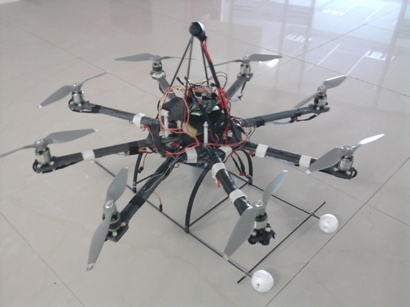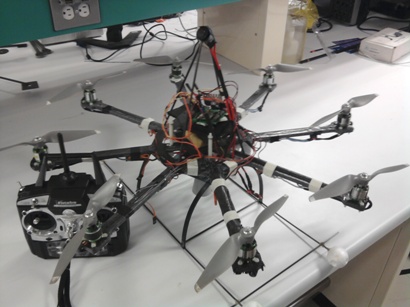Alejandro SAMANO
MSc Student
Master project: "Design and control of a helicopter with eight rotors"
Advisors: R. Lozano and R. Castro (Mechatronics)
Abstract
 Quadrotors have demonstrated to be reliable platforms which can be used to test innumerable control techniques, computer vision algorithms, multiagents systems concepts, aerial photograpy, etc. Construction and stabilization of an eight rotor helicopter are the goals of the thesis project. The main advantages of an eight rotors helicopter over a quadrotor are, the capability of carring larger payloads and to remain in the air despite the failure of one motor, under certain limitations. Like all mechanical systems it has drawbacks, high power consumption leads to short flights and bigger dimensions restrict their use to outdoors scenarios.
Quadrotors have demonstrated to be reliable platforms which can be used to test innumerable control techniques, computer vision algorithms, multiagents systems concepts, aerial photograpy, etc. Construction and stabilization of an eight rotor helicopter are the goals of the thesis project. The main advantages of an eight rotors helicopter over a quadrotor are, the capability of carring larger payloads and to remain in the air despite the failure of one motor, under certain limitations. Like all mechanical systems it has drawbacks, high power consumption leads to short flights and bigger dimensions restrict their use to outdoors scenarios.
The design of the helicopter has followed UAVs principles and methodologies based on computer aided design. Carbon fiber and aluminum have been used to build up the structure, which results on a stiff and low weight copter. Avionics is conformed by an Attitude and Heading Reference System (AHRS) and a Digital Signal Processor (DSP) responsible for calculating and sending the appropriate commands to the rotors. So far, linear control strategies have been programmed on the embedded system; those have demonstrated to be good enough to stabilize the copter and as a pilot-control augmented system. Nonlinear control strategies are being developed and programmed so as to compare and contrast them with the hope of better stability.
build up the structure, which results on a stiff and low weight copter. Avionics is conformed by an Attitude and Heading Reference System (AHRS) and a Digital Signal Processor (DSP) responsible for calculating and sending the appropriate commands to the rotors. So far, linear control strategies have been programmed on the embedded system; those have demonstrated to be good enough to stabilize the copter and as a pilot-control augmented system. Nonlinear control strategies are being developed and programmed so as to compare and contrast them with the hope of better stability.
Alejandro Sámano received his Engineer degree in Mechatronics Engineering from Instituto Politécnico Nacional, UPIITA-IPN, Mexico, in 2010. Currently, he is enrolled on a postgraduate Mechatronics program in the Department of Electric Engineering at CINVESTAV-IPN, Mexico. He collaborates with UMI-LAFMIA in the design, construction and stabilization of an eight rotors helicopter capable of autonomous flight. His research interests focuses on the modeling and control of mobile robots, autonomous aerial vehicles, and synchronization of multivehicle systems.